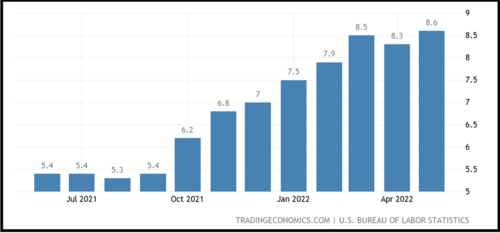
Gold weaker – "volatility collapse" portends bigger price move soon
Gold prices are modestly lower in midday U.S. trading Wednesday, in more subdued mid-summer trading. However, there has been a “collapse in volatility” on the daily bar chart, which suggests a significantly bigger price move is on the horizon in gold—possibly yet this week. Given that gold prices are trending lower on the daily chart, odds favor that bigger price move being on the downside. Improved trader/investor risk appetite this week is keeping buyers in the safe-haven metals mostly standing on the sidelines. August gold futures were last down $4.90 at $1,705.80. September Comex silver futures were last up $0.042 at $18.76 an ounce.
Global stock markets were mostly higher overnight. U.S. stock indexes are firmer near midday. The U.S. stock index bulls are having a good week so far and have restarted near-term price uptrends on the daily charts. Corporate earnings reports are on the front burner of the stock markets this week. Otherwise, its summertime doldrums trading amid a lack of major, fresh news.
Traders and investors are looking ahead to Thursday when the European Central Bank holds its regular monetary policy meeting. The ECB is expected to raise interest rates for the first time in 11 years, with many market watchers looking for a 0.5% rate increase. The U.S. Federal Reserve is expected to raise its key interest rate by at least 0.75% at next week’s FOMC meeting.
 Copper/gold ratio shows Fed monetary policy is too tight – MKS PAMP
Copper/gold ratio shows Fed monetary policy is too tight – MKS PAMP
The key outside markets today see Nymex crude oil prices weaker and trading around $103.50 a barrel. The U.S. dollar index is slightly higher in midday U.S. trading. The yield on the 10-year U.S. Treasury note is fetching 3.164%. The 2-year and 10-year Treasury bond yields remain inverted at mid-week, which is one clue of an impending U.S. economic recession.
.gif)
Technically, August gold futures bears have the solid overall near-term technical advantage. Prices are trending lower on the daily bar chart. However, the recent “collapse in volatility” on the daily bar chart (whereby at least three price bars in a row are significantly smaller than previous price bars) suggests a bigger price move is coming soon. It’s important to note that markets typically vacillate between periods of higher volatility and lower volatility, and at present the gold market is in a period of low volatility. Bulls’ next upside price objective is to produce a close above solid resistance at $1,750.00. Bears' next near-term downside price objective is pushing futures prices below solid technical support at $1,650.00. First resistance is seen at this week’s high of $1,722.00 and then at $1,735.00. First support is seen at $1,700.00 and then at the July low of $1,695.00. Wyckoff's Market Rating: 1.5.
.gif)
September silver futures bears have the solid overall near-term technical advantage. Silver bulls' next upside price objective is closing prices above solid technical resistance at $20.00. The next downside price objective for the bears is closing prices below solid support at $17.00. First resistance is seen at today’s high of $19.03 and then at $19.36. Next support is seen at this week’s low of $18.51 and then at $18.00. Wyckoff's Market Rating: 1.5.
September N.Y. copper closed up 405 points at 333.05 cents today. Prices closed near mid-range today. The copper bears have the solid overall near-term technical advantage. A steep six-week-old price downtrend is in place on the daily bar chart. Copper bulls' next upside price objective is pushing and closing prices above solid technical resistance at 375.00 cents. The next downside price objective for the bears is closing prices below solid technical support at 315.00 cents. First resistance is seen at today’s high of 337.55 cents and then at 340.00 cents. First support is seen at 325.00 cents and then at the July low of 313.15 cents. Wyckoff's Market Rating: 1.5.
By Jim Wyckoff
For Kitco News
Time to buy Gold and Silver on the dips
Tim Moseley


 The gold market has turned bearish
The gold market has turned bearish.gif)
.gif)

 Gold hammered, analysts warn of capitulation event if price drops below pre-pandemic levels
Gold hammered, analysts warn of capitulation event if price drops below pre-pandemic levels.gif)
.gif)





 This is why gold is below $1,800 even as U.S. inflation hits a 40-year high at 9.1%
This is why gold is below $1,800 even as U.S. inflation hits a 40-year high at 9.1%








 Gold faces a difficult second half but it's not hopeless – World Gold Council
Gold faces a difficult second half but it's not hopeless – World Gold Council